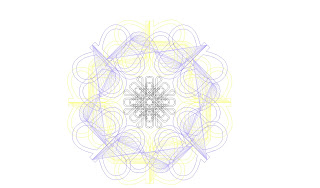
Tuesday, September 27, 2011
The Pattern I used from last week's exercise was translated from the original before this weeks project was begun . Instead of repeating the pattern as was done before, I took the base grouping of the translated letters and rotated them about a central axis. The resulting pattern was much more dynamic than the original pattern with much more overlap and complexity. That modified pattern is pictured here at the left. My 3D translations were a result of analyzing the layers that were created in the new pattern and extruding them to different heights in order to accentuate both their importance and to create a balance between them. For example the two layers making up the outside pattern are far larger than the two patterns making up the interior pattern. In order to balance the composition then I gave them lower heights as 3D extrusions and gave the two center layers higher heights in order to give them a greater importance despite their relatively small size in pattern. By using this system of extrusion there was also a compositional hierarchy and flow to the 3D pattern and that was further reinforced by the color scheme. The color scheme was taken from the last exercise and modified so that the layers would read well. The background was kept white and the colors get darker as they ascend, going from yellow to blue to black. I chose to keep both interior layers black in order to limit the color palette and reduce confusion within the pattern. I gave all of the surfaces reflective qualities, the yellow and blue being chrome finishes, and the black being a glossy finish texture. This made it so that the light source would show the curves and shadows more effectively. I also was required to add an extra light source to bolster the shading quality and so that the overlapping black layers could be seen clearly. I chose to take the orthographic views from the top because they best preserved the original pattern and a section cut would not be nearly as informative. The top view also contrasted nicely with the axon view by showing relatively little depth other than the cast shadows. The final rendered and wireframe images are shown below.


Subscribe to:
Post Comments (Atom)




No comments:
Post a Comment